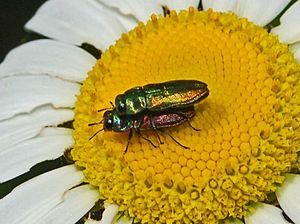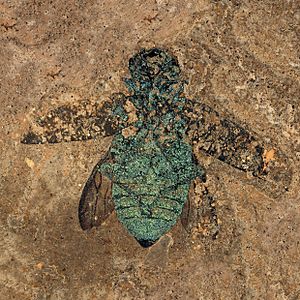Buprestidae facts for kids
Jewel beetles are a type of beetle known for their amazing, shiny colors. They are also called 'metallic wood-boring beetles' because of their bright, metallic-looking shells. This family of beetles, called Buprestidae, is one of the biggest beetle families. There are about 15,000 different kinds (species) of jewel beetles alive today. Scientists have also found nearly 100 kinds that lived long ago as fossils.
Contents
What Do Jewel Beetles Look Like?
Jewel beetles come in many shapes. They can be long and thin, or more oval-shaped. Most are smaller than 20 millimeters (about 0.8 inches). However, some types like Catoxantha and Megaloxantha can grow much larger, up to 80 millimeters (about 3 inches) long!
These beetles are famous for their bright, shiny colors. They often have complex patterns. Their amazing shimmer isn't from paint or color in their skin. Instead, it's caused by something called structural coloration. This means tiny textures on their hard outer shell (exoskeleton) reflect light in special ways. It's similar to how a compact disc (CD) reflects many colors when light hits it.
Where Do Jewel Beetles Live and What Do They Eat?
The young jewel beetles, called larvae, live inside plants. They bore tunnels through roots, logs, stems, and leaves. They can be found in many different plants, from tall trees to small grasses.
Most wood-boring jewel beetle larvae prefer to eat wood from dying or dead branches. Some types, however, attack healthy, green wood. A few of these can be serious pests. For example, the emerald ash borer can harm and even kill ash trees. This causes big problems for forests and people.
Some jewel beetles are very special because they are attracted to forests that have recently burned. They can sense pine wood smoke from as far as 50 miles away! They can also see infrared light. This helps them fly directly towards a forest fire to lay their eggs.
Life Cycle of Wood Borers
Many types of jewel beetles, especially the 'flatheaded borers', feed on spruce and fir trees. But they like hemlock trees the most. Like other wood borers, they mostly feed on dead or dying trees. They also feed near injured spots on living trees. A lot of damage only happens if there are always new dead trees for them to live in.
The life of these borers is similar to other wood-boring beetles. However, some jewel beetles can live for a very long time if conditions are difficult. Full-grown larvae can be up to 25 millimeters long. They are usually flat, with the front part of their body much wider than the rest. The adult beetles are often a shiny bronze color. You usually see them in sunny places where there are suitable trees for them to lay eggs.
Images for kids
See also
 In Spanish: Bupréstidos para niños
In Spanish: Bupréstidos para niños
















